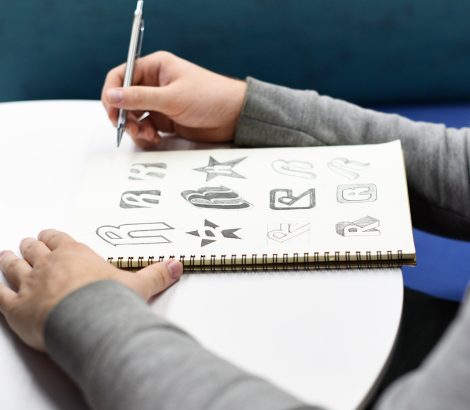In the realm of visual identity, the terms “logo design” and “branding design” are often used interchangeably. However, they carry distinct meanings and play different roles in shaping a business’s image. In this post, we’ll delve into the nuances that set these two design elements apart and explore how they collectively contribute to a strong brand presence.
Logo Design: A Visual Symbolism

A logo is a graphical representation of a business or product. It serves as an emblematic symbol that encapsulates a company’s essence. A well-crafted logo instantly communicates the nature of the business, its values, and its personality. A logo is typically composed of typography, imagery, colors, and shapes carefully chosen to create a memorable visual identity. It acts as a point of recognition, fostering brand familiarity among customers.
Branding Design: Beyond the Visual

Branding design, on the other hand, extends far beyond the visual aspects. It encompasses the entire spectrum of how a brand is perceived and experienced by its audience. Branding involves crafting a unique identity, voice, and emotional connection with customers. This includes elements like the brand’s mission, values, messaging, and even the way employees interact with clients. A cohesive branding strategy creates a holistic brand experience that fosters loyalty and trust.
The Synergy: Logo and Branding Design
While logo design and branding design differ in scope, they are inherently interconnected. A logo is a vital component of branding, serving as a recognizable visual cue. However, a logo alone cannot convey the entirety of a brand’s story. This is where branding design steps in. It weaves the logo into a larger narrative, aligning it with the brand’s core values and positioning.
FAQs About Logo and Branding Design
Q1: Can a logo change as part of a branding redesign? Yes, a logo might undergo subtle changes to align with the new branding while retaining its core elements.
Q2: Is branding only relevant for large businesses? No, branding is essential for businesses of all sizes. It helps create an identity and fosters customer loyalty.
Q3: How often should a company revisit its branding strategy? Branding should be reviewed whenever there’s a significant shift in business direction or target audience.
Conclusion: Crafting a Lasting Impression
In summary, the difference between logo design and branding design lies in their scope and purpose. A logo is a visual representation, whereas branding design encompasses a broader, holistic approach to shaping a brand’s identity. Both are integral to creating a lasting impression in the minds of customers. A successful brand harmonizes these elements to convey not only its offerings but also its values, fostering a deep and enduring connection.
As you embark on your branding journey, remember that a well-designed logo is just the tip of the iceberg. It’s the cohesive branding strategy that dives beneath the surface, guiding your brand’s growth and leaving an indelible mark on your audience.
So, whether you’re a startup or an established enterprise, investing in both logo and branding design is the first step toward building a brand that stands the test of time.
What’s your take on the logo vs. branding debate? Share your thoughts below!





What is a Branding Design? Unveiling the Greatness of Visual Identity
In today’s fast-paced business landscape, standing out from the crowd is crucial. This is where branding design steps in – an artful process that goes beyond just creating a logo. It’s about crafting a visual identity that resonates with your audience, communicates your values, and leaves a lasting impression. Let’s dive into the world of branding design and explore its significance for businesses.
Understanding Brand Design
Branding design encompasses the visual elements that make your business unique. It’s a blend of colors, typography, logos, and imagery that come together to form a consistent and memorable identity. Think of brands like Apple, Nike, or Coca-Cola – their logos and visual elements instantly evoke recognition and emotions.
The Key Components
1. Logo
A logo is the cornerstone of your branding design. It’s a symbol that encapsulates your brand’s essence. Ensure it’s simple, scalable, and reflects your brand’s personality.
2. Colors and Typography
Select a color palette that resonates with your brand’s message. Colors evoke emotions, so choose wisely. Pair it with suitable typography that enhances readability and consistency.
3. Imagery
Images can speak volumes. Use photos and graphics that align with your brand’s values. Each image should tell a part of your brand’s story.
Importance of Brand Design
A well-crafted branding design offers numerous benefits:
FAQs About Branding Design
Q1: Can a small business afford brand design? Absolutely! Branding design is an investment that pays off in the long run. You can start with a basic design and gradually build upon it.
Q2: How long does the brand process take? The timeline varies based on the complexity of your brand. It can take a few weeks to a few months to create a comprehensive branding design.
Q3: Can I change my brand design in the future? While consistency is crucial, brands evolve. You can refresh your branding design to align with your brand’s growth and changes.
Q4: What elements should I prioritize in my brand design? Focus on a strong logo, a harmonious color palette, and visuals that reflect your brand’s essence and values.
Crafting Your Unique Brand Design: Conclusion
In a world overflowing with options, a strong branding design sets you apart. It’s the visual story that communicates who you are, what you stand for, and why customers should choose you. Remember, branding design isn’t just about aesthetics; it’s about creating a powerful connection with your audience.
Invest today, and pave the way for a remarkable tomorrow.
Don’t settle for blending in – stand out with a captivating brand design that leaves a mark in the minds and hearts of your audience.
In the competitive business world, effective brand design is essential. It’s more than a logo – it’s an identity that resonates, communicates values, and makes a lasting impact. Explore the world of branding design’s significance.